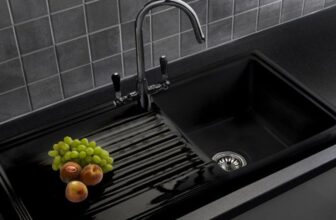Farmhouse Sink Vs Undermount Sink – What’s The Difference?
No matter if you’re building a new home or just remodeling the kitchen, the type of sink to install is one of the most significant decisions you’ll make.
Besides influencing the kitchen’s entire look and often being the focal point of the whole area, the sink is something you’ll likely use daily.
So, it will have a great impact on your comfort in the kitchen, the overall feel of the space, and the ease with which you’ll perform kitchen chores.
Therefore, it’s very important to get it right,
Still, when faced with a vast variety of different choices, finding the sink that is perfect for your kitchen is not easy.
For many, the choice often comes down to farmhouse or undermount sink.
Below, I’ll take a closer look into these two very popular options and compare the farmhouse sink vs undermount sink to see how they fare against each other.
| Farmhouse Sink | Undermount Sink | |
| Design | Characterized by an exposed front apron and a deep basin | Mounts underneath the countertop with a rimless design |
| Material Options | Typically made of porcelain or fireclay, but also available in stainless steel or copper | Available in a variety of materials, including stainless steel, porcelain, and cast iron |
| Installation | Requires a custom cabinet and countertop cutout to accommodate the sink’s size and depth | Can be installed on any countertop surface with a suitable cutout |
| Maintenance | Easier to clean due to the large, open design | Requires more care to keep the seam between the sink and countertop clean |
| Style | Often associated with a rustic, traditional aesthetic | Offers a sleek, modern look |
Table of Contents
Farmhouse Sink
The main visual characteristic of the farmhouse sink and the one that will help you unmistakably recognize it is its unique apron-front design.
This means that they have an exposed, front-facing side or front panel that’s cut into the kitchen cabinetry.
It adds to the aesthetic of the whole kitchen area and, depending on the farmhouse sink material, can create an interesting contrasting visual with the cabinet.
The front apron also has a practical purpose as it eliminates the need to lean forward to reach the sink.
As for installation, both undermount and topmount varieties are available.
Another major feature of a farmhouse sink is its rectangular basin, typically larger and deeper than on other sink types.
This dates back to the days before indoor plumbing when large farm families used sinks for multiple purposes.
However, it’s still very convenient and helps with washing bulkier pots, pans, and other dishes.
Pros and Cons of Farmhouse Sinks
Farmhouse sinks are highly popular because they bring many benefits to your home. However, there are some downsides to installing them in your kitchen.
Undermount Sink
Simply said, the undermount sink is a sink that sits underneath the countertop.
Its edge is below the level of the countertop which creates a seamless counter visual line and provides a sleek and modern look as the rim of the sink is hidden from direct view.
In addition, this also makes the countertop easier to clean as you can just wipe any dirt, spills, or other messes directly from the countertop to the sink.
This sink itself is supported by the base cabinets and attached to the bottom side of the countertop.
The rim is secured and attached to the countertop with metal and adhesive clops. This can make the installation a bit tricky, as you want the sink/countertop line to be perfect.
Undermount sink is available with both single and double basin, and can be made of different materials, including cast iron, stainless steel, copper, etc.
Pros and Cons of Undermount Sinks
Installing undermount sinks is beneficial in multiple ways, but there are a couple of drawbacks to having them as your kitchen sinks.
Farmhouse Sink Vs Undermount Sink – What’s The Difference?
Comparing a farmhouse sink vs undermount sink reveals that they have some similarities and, of course, serve the same primary purpose – soaking and washing the dishes.
However, there are some significant differences that you should take a look at now if you’re thinking of installing either one of these two sinks.
Cost
Before looking into other features and characteristic, many homeowners are interested in how each sink would fit into their budget.
While this will depend on material used and the brand of the sink, in general, farmhouse sinks are more expensive than their undermount counterparts.
The price of a farmhouse sink can even go up to a couple of thousands of dollars.
In addition to the cost of the sink, you should also pay attention to the price of installation. Installing either of these types of sinks will likely require hiring professional help.
Besides, installing any extra features, such as a garbage disposal unit, will drive the price up and probably call for extra help.
Installation
Installing either of these sinks will require some experience and expertise.
Due to their large size, farmhouse sinks may require sacrificing some cabinet space or a couple of drawers to make sure there’s enough room for plumbing.
The installation of the farmhouse sink may also involve modifying the existing countertop to fit a farmhouse sink and cutting it to the size.
Typically, farmhouse sinks are hung off two short brackets placed on the top of the counters and bolted to the wall.
Undermount sink installation requires plenty of precision, too.
Commonly, they’re attached to the underside of the countertop by using special kinds of washers and screws.
They must be fitted to the countertop with the utmost precision, so there are no leaks. Once fitted, an undermount sink must be held in place until the sealant is applied and dried.
This is the only way to achieve the desired seamless look.
Weight
The installation process and whether you can go through with it by yourself will also depend on the weight of the sink.
While the weight of the specific sink may vary due to the different materials used, farmhouse sinks are generally heavier than the undermount ones.
Typically, they weigh around 100 pounds or more, while undermount sinks weigh 20-25 pounds on average.
Durability
The durability of the farmhouse and undermount sinks will mainly depend on the materials used in their manufacturing process.
Typically, materials such as porcelain that are prone to chipping and cracking will provide less durability, as you’re likely to occasionally and unintentionally drop heavier dishes into the sink.
In addition, undermount sinks feature more complicated plumbing and are harder to refit. This means that they’re harder to replace or repair than farmhouse sinks.
Although heavier and bigger, farmhouse sinks are easier to replace as they’re only attached to the brackets.
Maintenance and Cleaning
Again, this will, to a large degree, depend on the material sink is made from.
As both farmhouse and undermount sinks can be made of a variety of materials, the ease of calling and maintenance may vary.
Typically, undermount sinks will require less maintenance and care over their life span than farmhouse sinks.
The latter need to be thoroughly cleaned rather regularly to avoid the buildup of bacteria, stains, or minerals.
On the other hand, undermount sinks are more protected and feature fewer nooks and crevices where dirt can get stuck.
Plus, undermount sinks, due to their edge being below the countertop level, make it easier to maintain a clean countertop, as you can easily swipe all the dirt straight to the sink.
When it comes to stain resistance, the advantage is on the side of farmhouse sinks. Flat surfaces and overflow drains are there to ensure that dirt doesn’t tick for too long.
The design of the undermount sink makes it a bit more prone to persistent stains.
Conclusion
The differences between the farmhouse and undermount sinks don’t make one type better than the other.
However, they do point to which of these sinks would be better for certain kitchen situations and existing interior design solutions.
Certainly, both types will serve their purpose and make your life in the kitchen easier.
Still, both have their advantages and disadvantages that can be more or less important depending on the type and style of the kitchen.
Farmhouse sinks are big statement pieces capable of handling larger pots and pans.
Undermount sinks will provide a more slick appearance and help provide more space around them.
So, ultimately, the choice should come down to your personal preference and your idea of how your kitchen should look and feel.
The most important thing is that you feel comfortable in your own kitchen and that the boring chore of dishwashing is at least a little bit easier.



















































































